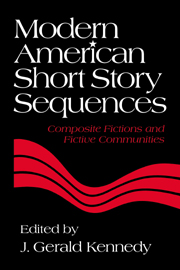Book contents
- Frontmatter
- Contents
- Contributors
- Introduction: The American Short Story Sequence – Definitions and Implications
- Henry James's Incipient Poetics of the Short Story Sequence: The Finer Grain (1910)
- Toomer's Cane as Narrative Sequence
- Hemingway's In Our Time: The Biography of a Book
- Wright Writing Reading: Narrative Strategies in Uncle Tom's Children
- The African-American Voice in Faulkner's Go Down, Moses
- Meditations on Nonpresence: Re-visioning the Short Story in Eudora Welty's The Wide Net
- Nine Stories: J. D. Salinger's Linked Mysteries
- Cheever's Shady Hill: A Suburban Sequence
- John Updike's Olinger Stories: New Light Among the Shadows
- Louise Erdrich's Love Medicine: Narrative Communities and the Short Story Sequence
- From Anderson's Winesburg to Carver's Cathedral: The Short Story Sequence and the Semblance of Community
- Index
Henry James's Incipient Poetics of the Short Story Sequence: The Finer Grain (1910)
Published online by Cambridge University Press: 29 September 2009
- Frontmatter
- Contents
- Contributors
- Introduction: The American Short Story Sequence – Definitions and Implications
- Henry James's Incipient Poetics of the Short Story Sequence: The Finer Grain (1910)
- Toomer's Cane as Narrative Sequence
- Hemingway's In Our Time: The Biography of a Book
- Wright Writing Reading: Narrative Strategies in Uncle Tom's Children
- The African-American Voice in Faulkner's Go Down, Moses
- Meditations on Nonpresence: Re-visioning the Short Story in Eudora Welty's The Wide Net
- Nine Stories: J. D. Salinger's Linked Mysteries
- Cheever's Shady Hill: A Suburban Sequence
- John Updike's Olinger Stories: New Light Among the Shadows
- Louise Erdrich's Love Medicine: Narrative Communities and the Short Story Sequence
- From Anderson's Winesburg to Carver's Cathedral: The Short Story Sequence and the Semblance of Community
- Index
Summary
Many critics of Henry James are aware that after he completed the arduous task of selecting his novels and tales for Scribner's or The New York Edition (1907–9), revising all the chosen texts and composing his dense theoretical Prefaces, James went on to write something important other than his now much interpreted travel memoirs and autobiographical volumes. In fact, he composed and published five final tales between March 1909 and April 1910 – “The Velvet Glove,” “Mora Montravers,” “Crapy Cornelia,” “The Bench of Desolation,” and “A Round of Visits”; then he quickly republished them in book form with a new title, The Finer Grain, in October 1910, and changed the order as follows: “The Velvet Glove,” “Mora Montravers,” “A Round of Visits,” “Crapy Cornelia,” and “The Bench of Desolation.” Because the New York Edition's Prefaces are generally regarded as a veritable apotheosis of James's lifelong artistry – even by those who now contextualize or else deconstruct them – the status of five final tales said to have just “missed” making The New York Edition seems at first a bit like that of five cabooses standing stationary on a track parallel to that of the enormous luxury train to which they might have been joined. Edward Wagenknecht's observation in this regard is the norm: “Since the publication of The New York Edition was completed in 1909,” he writes, “it was not possible to include any of them in that collection; they made their first appearance in book form in The Finer Grain (Scribner's, New York, and Methuen, London, 1910).”
- Type
- Chapter
- Information
- Modern American Short Story SequencesComposite Fictions and Fictive Communities, pp. 1 - 18Publisher: Cambridge University PressPrint publication year: 1995



